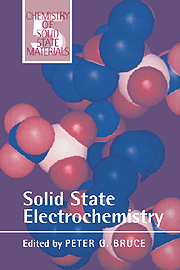Book contents
- Frontmatter
- Contents
- Preface
- 1 Introduction
- 2 Crystalline solid electrolytes I: General considerations and the major materials
- 3 Crystalline solid electrolytes II: Material design
- 4 Ionic transport in glassy electrolytes
- 5 Polymer electrolytes I: General principles
- 6 Polymer electrolytes II: Physical principles
- 7 Insertion electrodes I: Atomic and electronic structure of the hosts and their insertion compounds
- 8 Electrode performance
- 9 Polymer electrodes
- 10 Interfacial electrochemistry
- 11 Applications
- Index
10 - Interfacial electrochemistry
Published online by Cambridge University Press: 14 September 2009
- Frontmatter
- Contents
- Preface
- 1 Introduction
- 2 Crystalline solid electrolytes I: General considerations and the major materials
- 3 Crystalline solid electrolytes II: Material design
- 4 Ionic transport in glassy electrolytes
- 5 Polymer electrolytes I: General principles
- 6 Polymer electrolytes II: Physical principles
- 7 Insertion electrodes I: Atomic and electronic structure of the hosts and their insertion compounds
- 8 Electrode performance
- 9 Polymer electrodes
- 10 Interfacial electrochemistry
- 11 Applications
- Index
Summary
In this chapter we shall discuss both the theoretical and experimental aspects of the following types of interfaces:
(a) metal/polymer electrolyte, e.g. Li/PEO–LiCF3SO3 or Pt/PEO–LiCF3SO3;
(b) metal/crystalline ionically conducting solid, e.g. Ag/Ag4RbI5 or C/Ag4RbI5;
(c) aqueous salt solution/polymer electrolyte, e.g. AsPh4Cl-H2O/ AsPh4BPh4–PVC or KCl–H2O/AsPh4BPh4–PVC;
(d) polymer electrolyte/electronically and ionically conducting solid, e.g. PEO-LiCF3SO3/LixV6O13;
(e) solid electrolyte/solid electrolyte, e.g. Ag4RbI5/Ag-β-Al2O3.
We shall not attempt to review exhaustively the literature on interfacial electrochemistry in solid state systems. Instead we shall indicate the appropriate theoretical models for different situations. Most of the models and the related equations were developed some time ago in relation to the electrochemistry of aqueous systems. However, we will not assume a knowledge of these models on the part of the reader. It is important to realise that a direct transposition of models from one situation to another is fraught with difficulty, particularly since in aqueous electrochemistry a supporting electrolyte is generally present.
It is convenient for the purposes of this chapter initially to make a number of simplifying assumptions about the nature of the electrolytes under discussion. For example, Ag4RbI5 will be assumed to be an ionic conductor with negligible electronic conductivity and with only the silver ion mobile. Likewise Na-β-Al2O3 will be assumed to be a substance in which the only mobile charge is Na+.
Information
- Type
- Chapter
- Information
- Solid State Electrochemistry , pp. 264 - 291Publisher: Cambridge University PressPrint publication year: 1994
Accessibility standard: Unknown
Why this information is here
This section outlines the accessibility features of this content - including support for screen readers, full keyboard navigation and high-contrast display options. This may not be relevant for you.Accessibility Information
- 3
- Cited by
